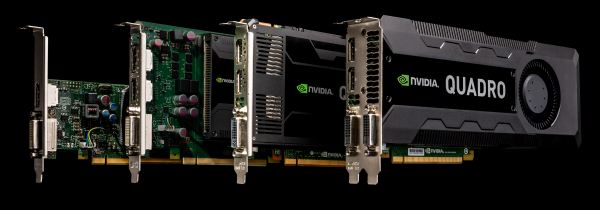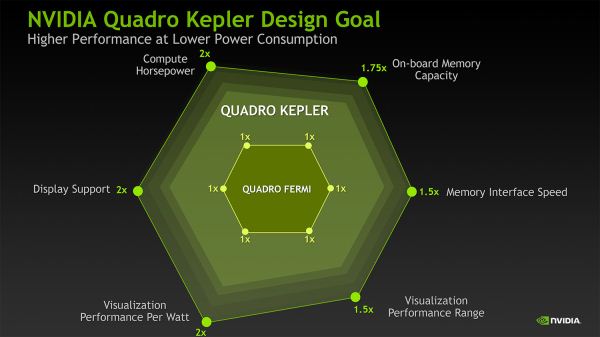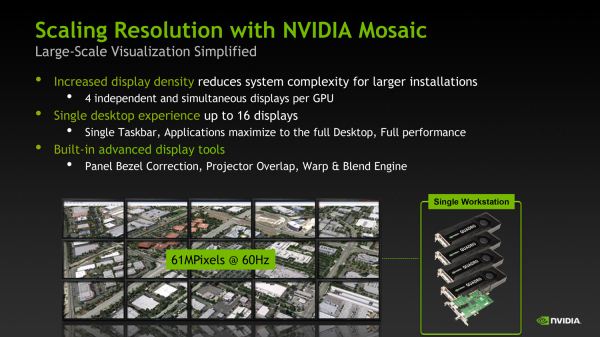NVIDIA Launches Quadro K4000, K2000, K2000D, & K600
by Ryan Smith on March 5, 2013 9:00 AM ESTBack in August of 2012 NVIDIA announced their first Kepler based Quadro part, the Quadro K5000. Based on NVIDIA’s at the time leading GK104 GPU, K5000 was the customary generational update to the workstation-focused Quadro family, bringing to the Quadro family Kepler generation features such as support for 4 monitors, NVIDIA’s NVENC video encoder, and of course greater rendering performance. However since its launch the K5000 has stood alone as the only Kepler based desktop Quadro card, with the older Fermi based products filling out the rest of the Quadro family. Today that will finally be changing as NVIDIA fleshes out the rest of the Quadro lineup with new Kepler based parts.
Altogether NVIDIA will be launching 4 new Quadro cards, intending to fill out the lower performance, higher volume market segments below the $2,250 K5000. These cards will be the K4000, the K2000, the K2000D, and the K600.
| Quadro K5000 | Quadro K4000 | Quadro K2000 | Quadro K600 | |
| Stream Processors | 1536 | 768 | 384 | 192 |
| Texture Units | 128 | 64 | 32 | 16 |
| ROPs | 32 | 24 | 16 | 16 |
| Core Clock | ~700MHz | ~800MHz | ~950MHz | ~875MHz |
| Memory Clock | 5.4GHz GDDR5 | 5.6GHz GDDR5 | 4GHz GDDR5 | 1.8GHz DDR3? |
| Memory Bus Width | 256-bit | 192-bit | 128-bit | 128-bit? |
| Frame Buffer | 4GB | 3GB | 2GB | 1GB |
| FP64 | 1/24 FP32 | 1/24 FP32 | 1/24 FP32 | 1/24 FP32 |
| Max Power | 122W | 80W | 51W | 41W |
| GPU | GK104 | GK106 | GK107 | GK107 |
| Architecture | Kepler | Kepler | Kepler | Kepler |
| Transistor Count | 3.5B | 2.54B | 1.3B | 1.3B |
| Manufacturing Process | TSMC 28nm | TSMC 28nm | TSMC 28nm | TSMC 28nm |
| MSRP | $2,249 | $1,269 | $599 | $199 |
Just as how the K5000 was the direct successor of the Fermi based Quadro 5000, these new cards are the direct successors of their respective Fermi counterparts, and will be occupying roughly the same market segments. At $1,269 will be the GK106 based K4000, which combines 768 CUDA cores with 3GB of RAM. Below that is the K2000 at $599, a GK107 based part packing 384 CUDA cores and 2GB of RAM. K2000 will come in two variants, a standard variant with 2 DisplayPorts and 1 DL-DVI port, and the K2000D which flips that for 2 DL-DVI ports and 1 mini-DisplayPort. Finally at $199 is a further cut down GK107 part, the K600, NVIDIA’s entry-level Kepler Quadro card featuring 192 CUDA cores, 1GB of RAM, and 1 DisplayPort along with 1 DL-DVI port.
Similar to how the Fermi Quadro cards were handled, the Kepler Quadro cards are essentially stratified based on a mix of features and performance. Partial ECC support for example will not make it down to any of these new cards, while NVIDIA’s GPUDirect for Video technology is being made available on the K4000 and above, but not the K2000 or K600. Meanwhile relative to their Fermi predecessors performance has increased across the board, with the specific gains varying with the SKU and the resource needs of any given application.
Of course the big draw for the Kepler Quadro family is Kepler’s improved display controller, which adds support for DisplayPort 1.2, support for 4K displays, and at the same time doubles the number of displays that can be driven from 2 on Fermi to 4 on most Kepler cards. Like the K5000, the K4000 and K2000 will be able to drive up to 4 displays, but in an important difference, owing to their smaller profiles these cards will not feature 4 display outputs. Rather in a first for NVIDIA, they will be relying in DisplayPort 1.2’s MST/daisy-chaining functionality to drive 2+ monitors off a single DP output.
Similarly, with the increased number of supported displays per card NVIDIA has upgraded their Mosaic software to match Kepler’s capabilities, increasing the number of displays that can be part of a mosaic. Mosaic now supports 16 displays spread over 4 video cards, for 4 displays per video card.
Finally, as with the Fermi generation of Quadro cards, the Kepler generation of Quadro cards will be top-to-bottom Maximus enabled for blended graphics/compute tasks. This means any Kepler Quadro card can be paired with a Tesla K20 to offload compute onto the K20 in supported applications, freeing up the Quadro card for graphical tasks while boosting compute performance. Given the $3000+ price tag on a K20 we don’t expect to see very many environments using Maximus with the K600, but from what we’ve seen in the past, Quadro 2000 series cards have ended up being Maximus pairings for use in tasks where a Quadro card is being used to visualize Tesla results.
On a final note, unlike the K5000 this will be a hard launch, so K4000, K2000, and K600 cards will be available starting today. This goes for both retail add-in card sales and for pre-built OEM systems, with OEMs shipping systems equipped with NVIDIA’s latest Quadro cards as soon as today.

























22 Comments
View All Comments
nevertell - Tuesday, March 5, 2013 - link
Well, is it really double the performance of the Fermi cards ? Maybe the 32-bit floating point computation is twice as fast, but I believe most scientific research is done (and should be done) with 64 bit precision.And what is the deal with the multimonitor scaling ? Couldn't that be achieved with any run of the mill consumer kepler card ?
Ktracho - Tuesday, March 5, 2013 - link
Tesla, not Quadro, cards are intended for scientific computing, where 64-bit processing is critical. They may even be slightly less expensive than equivalent Quadro cards, especially since there is no display connector on the latest (Kepler based) ones - they are not intended for visualization. They are also more reliable than normal display cards in terms of the trustworthiness of results.ShieTar - Wednesday, March 6, 2013 - link
I think the main target for Quadros are professional Image-processors and related pieces of software. Think camera-assisted operations, high-resolution satellite surveillance or industrial level CAD.32bit performance is good enough for any kind of image post-processing, when even the most expensive image sensors only come with a 16bit ADC. Its usually also good enough for any kind of physical/thermal simulation , e.g. virtual crash tests for cars, and the visualisations that go with it.
colonelpepper - Friday, March 8, 2013 - link
For a site so focused around games few people seem to know how that content is created. These are heavily used by CAD & 3D Apps, the prices are atrocious however for those who aren't in an industry situation who need these cards... such as art students seeking to enter into the special effects, gaming, movie, tv industries... and for hobbyists who use the same programs for fun and art.Maya
3DS Max
Mudbox
Vue (Eon Software)
Autocad
Aftereffects
Avid Software
...
...
...
domdym123 - Thursday, June 13, 2013 - link
Adobe premiertobiholz - Tuesday, March 5, 2013 - link
I hope Lenovo will adopt these for there new Thinkpad lineup ... the NVS5400m on the current t430 is just not fast enough :(ssnova - Wednesday, March 6, 2013 - link
These are already on the Thinkpad lineup, they have a mobile K2000M, K3000M, etc. series. You just have the wrong Thinkpad... T-series tops out at NVS series as does the Dell latitude series.... if you want the K Quadros, in a mobile setup you need workstation grade, ie: the W-series... so the Thinkpad W530 for example, has these cards, as well as the Dell Precision line, of course it costs more.domdym123 - Thursday, June 13, 2013 - link
Lenovo went with k1000m but you can upgrade it manually to the other k series you're self. $915 for the k5000m through dellBut if you go with a dell workstation you can opt for that nice 17.3 touch screen and 1-4 hdds. Plus backlit keyboard.
thampter14 - Tuesday, March 5, 2013 - link
...so I bought a FirePro W7000 from AMD. The card is awesome, and nothing I'm reading here has me regretting that decision. Plus I need Gen3 support because I am moving lots of data around, so it looks like a way better option.tobiholz - Tuesday, March 5, 2013 - link
I'm using a desktop with Intel HD3000 Graphics so even an old NVS5400m is an upgrade...But as I need the mobility I don't want to pay over 1.3k and then have no graphicpower ... epecially as it will be my main machine ;)